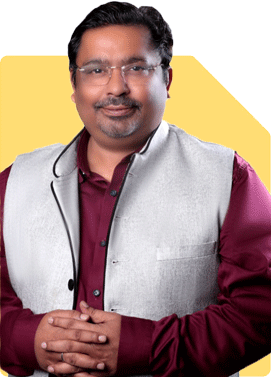Should I invest in the stock market or real estate with Rs 10 lakhs?
Ramalingam Kalirajan |10874 Answers |Ask -Follow
Mutual Funds, Financial Planning Expert - Answered on Apr 16, 2025
He has an MBA in finance from the University of Madras and is a certified financial planner.
He is the director and chief financial planner at Holistic Investment, a Chennai-based firm that offers financial planning and wealth management advice.... more

Col Sanjeev Govila, good evening. I am Col P Venkatachalam, retd from MCEME as HOD FIET in 2006. I want to invest Rs 10 lacs. Please advise me.
This response is structured for your complete understanding and peace of mind.
We’ll explore all angles: safety, growth, liquidity, and suitability for your life stage.
Let’s proceed step-by-step.
Understanding Your Needs First
Before investing, it's important to check a few things:
Do you need regular income from this amount?
Do you want to keep this money safe from loss?
Or, are you looking for long-term growth for legacy or future use?
Are you okay with some ups and downs in value for better returns?
Once your objective is clear, investment selection becomes easier and more purposeful.
If Your Priority Is Capital Safety with Some Growth
You may want to protect your money and still grow it better than FDs.
These types of investments are suitable for short-term or medium-term use.
You may explore actively managed short-duration debt mutual funds.
These funds give better returns than bank FDs in most cases.
Returns are not fixed but are usually in the range of 6% to 7.5% per year.
They also offer better tax efficiency compared to bank FDs.
You can redeem partially anytime if you need money.
These funds are managed by experts and reviewed regularly.
If Your Priority Is Monthly Income
If you want steady cash flows, you can consider this route.
Keep 6 to 12 months of expenses in a liquid fund.
Use the rest in a Systematic Withdrawal Plan (SWP) from a balanced hybrid fund.
SWP gives regular cash flow without touching your capital much.
You also get better post-tax returns than bank interest.
You can increase or stop SWP anytime you want.
If Your Priority Is Long-Term Wealth Creation
If you don’t need this money for at least 5 to 7 years, then growth becomes key.
You can consider investing in an actively managed equity mutual fund.
Your capital grows over the long term with the power of compounding.
You have already seen 5x growth in past equity investments.
That patience has rewarded you. Same can happen here.
Select only regular plans of equity funds through MFDs with CFP credentials.
Don’t choose direct plans as they give no guidance and no service.
Avoid index funds. They follow market blindly. They don’t manage risks well.
Actively managed funds perform better in changing market conditions.
Why Not Index Funds or Direct Plans
Many suggest index funds or direct mutual funds without understanding your life stage.
Index funds copy an index. No human checks or risk control.
During market falls, they fall just like the market. No safety layer.
They may not suit senior citizens looking for safer growth.
Also, direct plans have no support.
A Certified Financial Planner and MFD will guide and update you regularly.
They also ensure rebalancing and switching at the right time.
What to Avoid at This Stage
Don’t go for market-linked insurance plans like ULIPs or combo policies.
Don’t keep Rs 10 lakh idle in a savings account or low-interest FD.
Don’t lock the entire amount in long-term non-liquid products.
Don’t invest in real estate for rental income. It’s illiquid and stressful.
Tax Aspects to Keep in Mind
If you redeem your equity fund after 1 year, capital gains above Rs 1.25 lakh are taxed at 12.5%.
For debt funds, gains are taxed as per your income slab.
SWP from equity funds is treated as capital gains. So, tax is lower.
You can plan redemptions smartly to keep tax low.
Avoid dividend payout plans in equity funds. They deduct tax before payout.
Instead, choose growth option and withdraw through SWP. That’s tax-friendly.
Sample Allocation for Rs 10 Lakh Based on Your Profile
This is a balanced idea assuming you don’t need regular income.
Rs 2 lakh in liquid fund – for emergency or unexpected needs
Rs 3 lakh in short-duration debt fund – for medium-term use
Rs 5 lakh in actively managed large and mid-cap equity mutual fund – for long-term growth
If you need monthly income, then replace Rs 5 lakh equity with a balanced fund and start SWP.
This will give you regular income with capital protection.
Flexibility and Liquidity
All these options offer full liquidity. You can withdraw anytime.
No fixed lock-in like insurance or annuities.
You stay in control of your money.
You also avoid penalty or surrender loss.
Review and Adjust Every Year
Check the performance every year with a Certified Financial Planner.
Rebalance between equity and debt based on your age and goals.
Make sure you are not taking more risk than needed.
If markets have performed well, book some profit and move to safer options.
If You Already Have Any LIC, ULIP, or Combo Plans
If any LIC or ULIP policies exist, kindly check surrender value.
If they are giving poor return, consider surrendering and reinvest in mutual funds.
Many old plans give less than 5% return.
Mutual funds offer more transparency and liquidity.
Make sure to shift wisely and not impulsively.
You Have Already Done Well
You are retired and still planning ahead. That is very admirable.
You also understand that income from equity mutual funds is not guaranteed.
Your discipline in sticking with equity for long term is wise.
It’s rare to see 5 times growth. You must have chosen well and held strong.
Finally
Based on your need, risk comfort, and goal, we can mix liquid, debt, and equity.
Avoid products which lock your capital or give poor return.
Prefer actively managed mutual funds with guidance.
Avoid index funds, direct plans, and fixed-return insurance schemes.
Keep part of your money flexible for any future need.
Ensure that your capital works hard but remains under your full control.
Periodic review with a trusted Certified Financial Planner is a must.
Best Regards,
K. Ramalingam, MBA, CFP,
Chief Financial Planner,
www.holisticinvestment.in
https://www.youtube.com/@HolisticInvestment
You may like to see similar questions and answers below
Omkeshwar Singh | Answer |Ask -Follow
Head, Rank MF - Answered on Jul 18, 2022
Ramalingam Kalirajan |10874 Answers |Ask -Follow
Mutual Funds, Financial Planning Expert - Answered on May 08, 2024
Ramalingam Kalirajan |10874 Answers |Ask -Follow
Mutual Funds, Financial Planning Expert - Answered on May 17, 2024
Ramalingam Kalirajan |10874 Answers |Ask -Follow
Mutual Funds, Financial Planning Expert - Answered on Jul 08, 2024
Ramalingam Kalirajan |10874 Answers |Ask -Follow
Mutual Funds, Financial Planning Expert - Answered on Dec 08, 2025
Samraat Jadhav |2499 Answers |Ask -Follow
Stock Market Expert - Answered on Dec 08, 2025
Ramalingam Kalirajan |10874 Answers |Ask -Follow
Mutual Funds, Financial Planning Expert - Answered on Dec 08, 2025
Radheshyam Zanwar |6737 Answers |Ask -Follow
MHT-CET, IIT-JEE, NEET-UG Expert - Answered on Dec 08, 2025
Nayagam P P |10852 Answers |Ask -Follow
Career Counsellor - Answered on Dec 07, 2025

Research Career Prospects: IISc, IITs, and Beyond: For research-oriented careers, the Integrated M.Sc Physics program at Amrita provides an exceptional foundation. Amrita's curriculum specifically aligns with GATE and UGC-NET examination syllabi, and the institution emphasizes early research engagement. The faculty at Amrita actively publish research in Scopus-indexed journals, with over 60 publications in international venues within the past five years, exposing you to active research environments.
To pursue research at premier institutions like IISc, you would typically follow the PhD pathway. IISc accepts M.Sc graduates through their Integrated PhD programs, and with your Amrita M.Sc, you're eligible to apply. You'll need to qualify the relevant entrance examinations, and your integrated program's emphasis on research fundamentals provides strong preparation. The final year of your Integrated M.Sc is intentionally structured to be nearly free of classroom commitments, enabling engagement with research projects at institutes like IISc, IITs, and National Labs. According to Amrita's data, over 80% of M.Sc Physics students secured internship offers from reputed institutions during academic year 2019-20, directly facilitating research career transitions.
Placement and Direct Employment Opportunities: Amrita University boasts a comprehensive placement ecosystem with strong corporate and government sector connections. According to NIRF placement data for the Amrita Integrated M.Sc program (5-year), the median salary in 2023-24 stood at ?7.2 LPA with approximately 57% placement rate. However, these figures reflect general placement trends; physics graduates often secure higher packages in specialized technical roles. Many graduates join software companies like Infosys (with early offers), Google, and PayPal, where their strong analytical and computational skills command competitive compensation packages ranging from ?8-15 LPA for entry-level positions.
The Department of Corporate and Industrial Relations at Amrita provides intensive three-semester life skills training covering linguistic competence, data interpretation, group discussions, and interview techniques. This structured placement support significantly enhances your employability in both government and private sectors.
Government Sector Opportunities: UPSC, BARC, DRDO, and ISRO: Your M.Sc Physics degree opens multiple avenues for prestigious government employment. UPSC Geophysicist examinations explicitly list M.Sc Physics or Applied Physics as qualifying degrees, enabling you to compete for Group A positions in the Geological Survey of India and Central Ground Water Board. The age limit for geophysicist positions is 32 years (with relaxation for reserved categories), and the exam comprises preliminary, main, and interview stages.
BARC (Bhabha Atomic Research Centre) actively recruits M.Sc Physics graduates as Scientific Officers and Research Fellows. Recruitment occurs through the BARC Online Test or GATE scores, with positions in nuclear science, radiation protection, and atomic research. BARC Summer Internship programs are available, offering ?5,000-?10,000 monthly stipends with opportunity for future scientist recruitment.
DRDO (Defense Research and Development Organization) recruits M.Sc Physics graduates through CEPTAM examinations or GATE scores for roles involving defense technology, weapon systems, and laser physics research. ISRO (Indian Space Research Organisation) regularly advertises scientist/engineer positions through competitive recruitment for candidates with strong physics backgrounds, offering opportunities in satellite technology and space science applications.
Other significant employers include the Indian Meteorological Department (IMD) recruiting as scientific officers, and NPCIL (Nuclear Power Corporation of India Limited), offering stable government service with competitive compensation packages exceeding ?8-12 LPA for scientists.
Alternate Career Pathways: UPSC, CDS, and AFCAT: UPSC Civil Services (IFS - Indian Forest Service): M.Sc Physics graduates qualify for UPSC Civil Services examinations, with the forest service offering opportunities for science-based administrative roles with potential to reach senior government positions.
CDS/AFCAT (Armed Forces): While AFCAT meteorology branches specifically require "B.Sc with Maths & Physics with 60% minimum marks," the technical branches (Aeronautical Engineering and Ground Duty Technical roles) require graduation/integrated postgraduation in Engineering/Technology. An M.Sc Physics integrates well with technical qualifications, though you would need engineering background for direct officer entry. However, you remain eligible for specialized technical interviews if applying through alternate defence channels.
UGC-NET Examination: This pathway leads to Assistant Professor positions in central universities and colleges across India. NET-qualified candidates receive scholarships of ?31,000/month for 2-year JRF positions with PhD pursuit, transitioning to Assistant Professor salaries of ?41,000/month in government institutions. This route provides long-term academic career security with research opportunities.
Private Sector Technical Roles
M.Sc Physics graduates are increasingly valued in data science, software engineering, and technical consulting. Companies actively recruit physics graduates for software development, where strong problem-solving and logical reasoning translate to competitive packages of ?10-20 LPA. Specialized domains including quantum computing development, financial modeling, and scientific computing offer premium compensation. Your minor in Scientific Computing makes you particularly attractive to technology companies requiring computational expertise.
International Opportunities and Higher Studies Abroad
An M.Sc from Amrita facilitates admission to PhD programs at international institutions. German universities offer tuition-free or low-fee MSc Physics programs (2 years) with scholarships like DAAD providing €850+ monthly stipends. US universities accept M.Sc graduates directly for PhD positions with full funding (tuition coverage + stipend). These pathways require GRE scores and strong Statement of Purpose articulating research interests. Research collaboration opportunities exist with Max Planck Institute (Germany) and CalTech Summer Research Program (USA), both welcoming Indian M.Sc students.
Essential Skills and Certifications to Develop Immediately: Programming Languages: Start learning Python immediately—it's universally used in research and industry. Dedicate 2-3 hours weekly to data analysis, scientific computing libraries (NumPy, SciPy, Pandas), and machine learning fundamentals. MATLAB is equally critical for physics applications, particularly numerical simulations and data visualization. Aim to complete MATLAB certification courses within your first year.
Research Tools: Learn Git/version control, LaTeX for scientific documentation, and data analysis frameworks. These skills are indispensable for publishing research papers and collaborating on projects.
Certifications Worth Pursuing: (1) MATLAB Certification (DIYguru or MathWorks official courses) (2) Python for Data Science (complete certificate programs from platforms like Coursera) (3) Machine Learning Fundamentals (for expanding technical versatility) & (4) Scientific Communication and Technical Writing (develop through departmental workshops)
Strategic Internship Planning: Leverage Amrita's research connections systematically. In your third year, apply to BARC Summer Internship, IISER Internships, TIFR Summer Fellowships, and IIT Internship programs (like IIT Kanpur SURGE). These expose you to frontier research while establishing connections for future PhD or scientist recruitment. Target 2-3 research internships across different specializations to develop versatility.
TO SUM UP, Your Integrated M.Sc Physics degree from Amrita positions you exceptionally well for competitive research careers at IISc/IITs, prestigious government scientist roles at BARC/DRDO/ISRO, and international PhD opportunities. The program's scientific computing emphasis differentiates you in the job market. Immediate priorities: (1) Master Python and MATLAB within the first two years; (2) Engage in research projects starting year 2-3; (3) Target internships at premiere research institutions; (4) Prepare GATE while completing your degree for maximum flexibility in recruitment; (5) Consider UGC-NET for long-term academic stability. Your career trajectory will ultimately depend on developing strong research fundamentals, demonstrating consistent excellence in specialization areas, and strategically selecting internship and research opportunities. The rigorous Amrita program combined with disciplined skill development positions you for exceptional career success across multiple sectors. Choose the most suitable option for you out of the various options available mentioned above. All the BEST for Your Prosperous Future!
Follow RediffGURUS to Know More on 'Careers | Money | Health | Relationships'.
Nayagam P P |10852 Answers |Ask -Follow
Career Counsellor - Answered on Dec 07, 2025
Radheshyam Zanwar |6737 Answers |Ask -Follow
MHT-CET, IIT-JEE, NEET-UG Expert - Answered on Dec 06, 2025

Good luck.
Follow me if you receive this reply.
Radheshyam
Dr Nagarajan J S K |2576 Answers |Ask -Follow
NEET, Medical, Pharmacy Careers - Answered on Dec 06, 2025
Mihir Tanna |1090 Answers |Ask -Follow
Tax Expert - Answered on Dec 06, 2025
Ramalingam Kalirajan |10874 Answers |Ask -Follow
Mutual Funds, Financial Planning Expert - Answered on Dec 06, 2025











.jpg)














